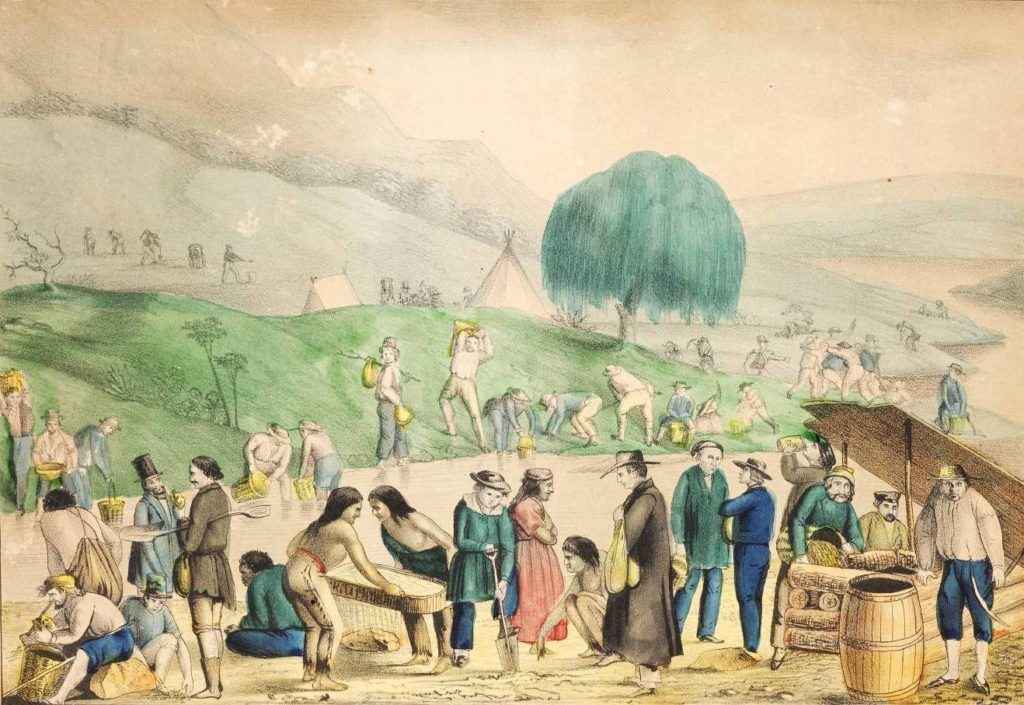The 49ers

Is the Kansas City Chiefs an offensive name? Yes, albeit not quite as horrifying as the Washington Redskins. But is the San Francisco 49ers really much better? No, since the Gold Rush and the following years was a massive exercise in genocide and racial violence:
The conditions in the mining camp were rough and crude. Alcohol and weapons were everywhere, and violence often erupted. No laws governed the growing population in the new territory.
In one of the earliest conflicts, a group of white miners from Oregon barged into the nearby Maidu hamlet, beat and shot the men, and savagely assaulted a number of the women. A party of Maidu men retaliated by killing five of the miners, who then recruited a posse of 20 armed white men and invaded another nearby village. The sleeping Indians weren’t even members of the same Maidu tribe, but to the miners, it didn’t matter: Indian was Indian. They murdered 12 tribe members and took eight hostages. A few days later, they killed the hostages too.
With each passing day, more and more miners came to the goldfields. On average, $50 million worth of gold was unearthed every year between 1849 and 1857. Yet as the gold became more difficult to find, the early prospectors looked for other means of support, and California offered a wealth of prime real estate. All the property acquisition required was a little terrorism practiced on the country’s original inhabitants.
Meanwhile, in Washington, D.C., the Mexican-American War hero Zachary Taylor swept into the White House with fresh vigor. Having spent most of his military career fighting Indians, “Old Rough and Ready” Taylor declared himself keen to move the country into an era of peace and prosperity. Congress created a new omnibus federal agency—the Department of the Interior—and transferred Indian affairs to its care from the War Department.
Taylor and his Indian affairs advisers were excited to test an idea that had been attracting growing interest. Stephen A. Douglas, the Illinois senator whose seat would later be challenged by Abraham Lincoln, proposed extinguishing Indian land ownership in the far West by establishing expansive plots of land where “Indians may be permanently located and protected.” (This proposal was the beginning of today’s reservation system.) But first, Taylor had to bring civil order to California, and that meant statehood.
While local white settlers awaited the territory’s entry into the union, they pressed ahead with the formation of a state government. After a newly constituted legislature created the governor’s office, a judicial system, and penalties for cattle rustling, the 49er legislators turned to the business of installing the state-fortified foundations of white supremacy.
They first adopted statutes that forced people designated as “foreigners”—that is, anyone who was not an American of northern European ancestry—to pay a monthly $20 tax for the right to work in the goldfields. That levy produced its intended effect: an exodus of nonwhites from the mining region.
The 49ers then enacted the Act for the Government and Protection of Indians, also called Chapter 133, which, contrary to its name, stripped California’s Indians of nearly all legal protections.
Under Chapter 133, a white man desirous of Indian land needed only to present his request to the local justice of the peace, who would determine the minimum amount of land he reckoned a local tribe needed. After keeping a small portion for the Indians, the justice held the power to sell or grant the excess property to any chosen white man, who could, with the same magistrate’s permission, kidnap Indian children and “adopt” them—or keep the youths as unpaid houseworkers and field hands until they reached the age of majority.
Chapter 133’s most abhorrent clause stated, “In no case shall a white man be convicted of any offence upon the testimony of an Indian, or Indians.” With those 20 words, California effectively legalized the rape, robbery, and murder of any Native American within the boundaries of the state.
The white men of the Golden State exercised their homicidal liberty. The following year, The Sacramento Union published this news item:
An Indian was murdered in Santa Barbara recently under circumstances which call loudly for the establishment of a Vigilance Committee. He was called from his house by a [local white man], whose name we did not learn, and who without any provocation whatever, plunged a knife into his heart, killing him instantly.
Some four or five Indians were present, witnesses to the transaction, and they pursued the murderer, caught him and carried him before a magistrate. Will it be believed that he was almost immediately released from custody, because our laws will not allow an Indian to testify against a white man?
The Indians in this part of the State, in the main a harmless race, are left entirely at the mercy of every ruffian in the country, and if something is not done for their protection, the race will shortly become extinct.
Nov. 14, 1851
The law’s final section established a form of state-sponsored slavery. Any able-bodied Indian “who shall be found loitering and strolling about,” the law decreed, “shall be liable to be arrested on the complaint of any resident citizen of the county.” Once arrested, the Indian would be brought before a mayor, magistrate, or county clerk and put up for auction. “Such vagrant,” as the law described the Indian, would be hired out for four months “for the highest price that can be had.”
Suffice it to say that most, though by no means all, all of the people involved in this were northerners, many of whom were abolitionists, and some of whom were engaging in open slavery of Native Californians well into the 1870s.
